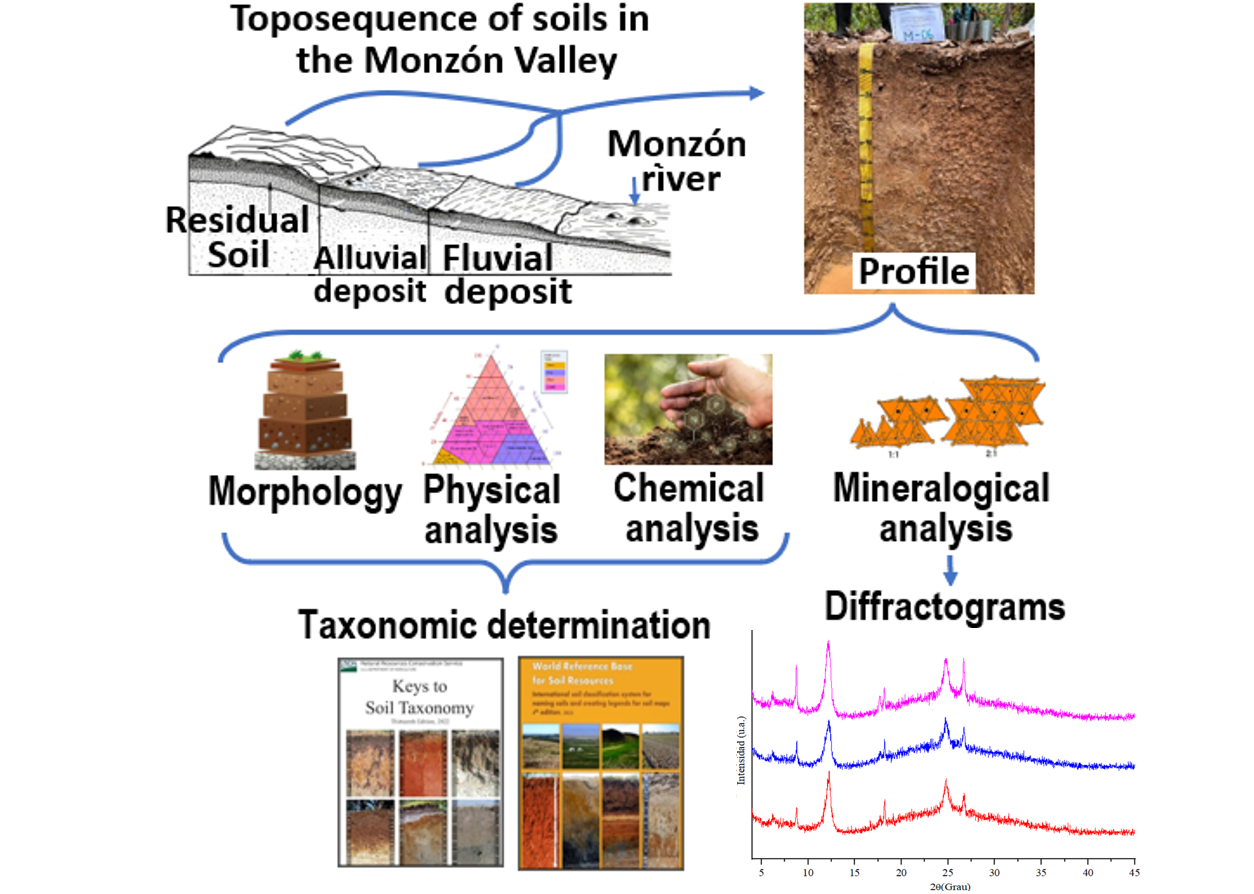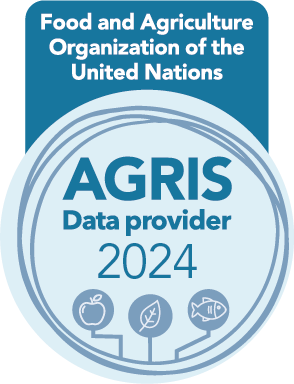Soil variability in a toposequence of the Monzón Valley, high jungle of Peru: Morphology, properties and classification
DOI:
https://doi.org/10.17268/sci.agropecu.2026.009Keywords:
clay minerals, crystallinity, erosion, weatheringAbstract
Knowing the taxonomy, mineralogy, and properties of soils is essential to understand their genesis, functionality, and potential use, and it is fundamental for implementing land-use planning and to characterize soil use management systems. The objective of this study was to describe and correlate the taxonomic characteristics (Soil Taxonomy and World Soil Classification), morphological, physicochemical, and mineralogical characteristics of soils in relation to their physiographic position, based on 15 profiles of a toposequence obtaining 81 horizons. It was verified that soil variability was linked to relief; likewise, soil orders ranging from Entisols to Inceptisols were identified according to the Soil Taxonomy classification. While through the World Soil classification, the groups: Fluvisols, Regosols, Umbrisols, Cambisols, and Luvisols were identified. Morphologically, the fluvial soils were characterized by presenting Ap surface horizons, verifying the absence of subsurface horizons, denoting that they are young soils. In the physical attributes, there were sandy textures in fluvial soils and clayey textures in residual soils. Greater fertility was evidenced in lower terraces, and as the relief rises, fertility decreases. There was a correlation between physical and chemical attributes; in this sense, fertility depends to some extent on physical characteristics. The mineralogical analysis, using X-ray diffraction and X-ray fluorescence, revealed a predominance of 2:1 minerals in fluvial soils, associated with SiO₂/R₂O₃ molar ratios > 2; whereas in residual soils, 1:1 minerals predominated, with ratios < 2. Finally, fertility decreased according to soil origin: highest in fluvial soils, intermediate in alluvial soils, and lowest in residual soils.
References
Albers, A. P. F., Melchiades, F. G., Machado, R., Baldo, J. B., & Boschi, A. O. (2002). Um método simples de caracterização de argilominerais por difração de raios X [A simple method for the characterization of clay minerals by X-ray diffraction]. Cerâmica, 48(305), 34–37. https://doi.org/10.1590/S0366-69132002000100008
Alcalde-Aparicio, M., González-López, O., Fernández-Martínez, J. L., Álvarez-González, F., & Arias, D. (2023). Mineralogy and geochemical signatures as indicators of differential weathering in natural soil profiles from the West Asturian–Leonese Zone (NW Iberia). Catena, 226, 107036. https://doi.org/10.1016/j.catena.2023.107036
Arias, F., Mata, R., Alvarado, A., Serrano, E., & Laguna, J. (2010). Mineralogía de la fracción arcilla de algunos suelos cultivados con banano en las llanuras aluviales del Caribe de Costa Rica. Agronomía Costarricense, 34(2), 197–222. https://doi.org/10.15517/rac.v34i2.3632
Arthur, A., & Okae-Anti, D. (2022). Genesis and Classification of Soils from a Toposequence at Wamaso, Ghana. Open Access Library Journal, 9, e9108. https://doi.org/10.4236/oalib.1109108
Azañero Aquino, L., Ñique Álvarez, M., & Florida Rofner, N. (2020). Calidad del suelo en diferentes sistemas de uso en selva alta de Huánuco, Perú. Revista Tayacaja, 3(1), 29–40. https://doi.org/10.46908/rtayacaja.v3i1.75
Bastida, J., & Pardo-Ibáñez, P. (2024). Applications of X-ray Powder Diffraction Microstructural Analysis in Applied Clay Mineralogy. Minerals, 14(6), 584. https://doi.org/10.3390/min14060584
Bastidas-Obando, E., & Carbonell, J. A. (2010). Caracterización espectral y mineralógica de los suelos del valle del río Cauca por espectroscopía visible e infrarroja (400 - 2.500 nm). Agronomía Colombiana, 28(2), 291–301.
Bazán, R. (2017). Manual of procedures for soil and water analysis for irrigation purposes. National Institute for Agrarian Innovation – INIA.
Buol, S. W., Southard, R. J., Graham, R. C., & McDaniel, P. A. (2011). Soil genesis and classification (6th ed.). Wiley-Blackwell.
Chinchilla, M., Mata, R., & Alvarado, A. (2011). Caracterización y clasificación de algunos ultisoles de la región de Los Santos, Talamanca, Costa Rica. Agronomía Costarricense, 35(1), 59–81. https://doi.org/10.15517/rac.v35i1.6687
Cipriano-Silva, R., Valladares, G. S., Azevedo, A. C., Cunha dos Anjos, L. H., Pereira, M. G., & Pinheiro Júnior, C. R. (2020). Alluvial soil formation in the plains of northeastern Brazil: Soil in space and time – Genesis and soil morphology. Revista Brasileira de Ciência do Solo, 44, e0190110. https://doi.org/10.36783/18069657rbcs20190110
Cobo-Vidal, Y., Angarica Baró, E., Martín Gutiérrez, G., Serrano Gutiérrez, A., & Rodríguez Fajardo, A. (2024). Mineralogía y química de las arcillas en suelos Pardos y Vertisoles del Oriente de Cuba. Ingeniería Agrícola, 14(2). https://cuid.com/2284/v14n2e04
Munsell Color Company. (2012). Cartas de colores de suelo Munsell. Baltimore.
Corrêa de Medeiros, P. S., do Nascimento, P. C., Inda, A. V., & da Silva, L. F. (2020). Genesis and classification of soils from granitic hills in southern Brazil. Journal of South American Earth Sciences, 98, 102494. https://doi.org/10.1016/j.jsames.2019.102494
Damaceno, L. M. S., Carvalho, M. C., da Silva, L. F., & da Costa, A. C. S. (2020). Physical, chemical, morphological and mineralogical characterization surface and subsurface in hydromorphic and non-hydromorphic soil of the Central Amazon. Journal of Agricultural Science, 12(4), 245–258.
Danish, A., Totiç, E., Bayram, M., Sütçü, M., Gencel, O., Erdoğmuş, E., & Ozbakkaloglu, T. (2022). Assessment of mineralogical characteristics of clays and the effect of waste materials on their index properties for the production of bricks. Materials, 15(24), 8908. https://doi.org/10.3390/ma15248908
Dewangan, A., Mishra, P., Sahu, R., & Patel, S. (2024). The role of physico-chemical properties in soil functionality: A literature review. EPRA International Journal of Research and Development (IJRD), 9(4), 20–27.
Empresa Brasileira de Pesquisa Agropecuária (EMBRAPA). (1979). Serviço Nacional de Levantamento e Conservação de Solo: Manual de métodos de análise de solos.
FAO. (2009). Guía para la descripción de suelos (4.ª ed.). Organización de las Naciones Unidas para la Alimentación y la Agricultura. https://www.fao.org/3/i3794s/i3794s.pdf
FAO. (2021). Los pastizales y suelos: Una relación vital para la sostenibilidad. https://www.fao.org/documents/card/en/c/CB7222EN
Ferreira, D. N., Melo, V. F., Testoni, S. A., Vidal-Torrado, P., & de Oliveira, J. C. (2024). Origin and properties of kaolinites from soils of a toposequence in Southern Brazil. Revista Brasileira de Ciência do Solo, 48, e20230028. https://doi.org/10.36783/18069657rbcs20230028
Ferrier, K. & Perron, J. (2019). The Importance of Hillslope Scale in Responses of Chemical Erosion Rate to Changes in Tectonics and Climate. Journal of Geophysical Research: Earth Surface, 125(9), e2020JF005562. https://doi.org/10.1029/2018JF004856
Freixo, A., Machado, P., Guimarães, C., Silva, C., & Fadigas, F. (2002). Estoque de carbono e nitrogênio e distribuição de frações orgânicas de Latossolo do Cerrado sob diferentes sistemas de cultivo. Revista Brasileira de Ciência do Solo, 26, 425–434. https://doi.org/10.1590/S0103-84782012005000008
García-Angulo, K., & Lee, K. T. (2022). Detección de cambios en la forma del plano debido a la fluctuación estacional del caudal y la grave inundación de 2012 en el río Amazonas cerca de la ciudad de Iquitos, Perú, con base en el análisis de imágenes de teledetección. Water, 14(3), 509. https://doi.org/10.3390/w14030509
González, O. J., Bezada-Díaz, M., Del Valle Millán-Boadas, Z., y Carrera, J. M. (2013). Caracterización de las arenas y arcillas minerales de los depósitos de canal y planicie de inundación del río Portuguesa, Venezuela. Investigaciones Geográficas, Boletín del Instituto de Geografía, 85, 18–32. https://doi.org/10.14350/rig.35291
IUSS Working Group WRB. (2022). World reference base for soil resources: International soil classification system for naming soils and creating legends for soil maps (4th ed.). International Union of Soil Sciences.
Jasso-Castañeda, C., Gama Castro, J. E., Solleiro Rebolledo, E., & Díaz Ortega, J. (2012). Morfogénesis, procesos y evolución del horizonte Bw cámbico en tefrapaleosuelos del volcán Nevado de Toluca. Boletín de la Sociedad Geológica Mexicana, 64(1), 37–47.
Kämpf, N., & Curi, N. (2012). Formação e evolução do solo (gênese). In J. C. Ker (Eds.), Pedologia: Fundamentos (pp. 207–292). Sociedade Brasileira de Ciência do Solo.
Lama, D. A. I., Schaefer, C. E. G. R., Amaral, E. F., do Vale Lopes, D., Francelino, M. R., & Senra, E. O. (2024). Soil–landform interplays from the highlands of the Eastern Andes Cordillera to the lowlands of the Peruvian Amazon. Catena, 244, 108248. https://doi.org/10.1016/j.catena.2024.108248
Martínez, W., Valdivia, E., & Cuyubamba, V. (1998). Geología de los cuadrángulos de Aucayacu, Río Santa Ana y Tingo María. Hojas: 18-k, 18-l y 19-k (Boletín, Serie A: Carta Geológica Nacional, 112). INGEMMET.
Menezes, M. D., Oliveira, I. A., Souza, B. F., & Silva, E. M. (2023). Different quartz varieties characterized by proximal sensing and their relation to soil attributes. Minerals, 13(4), 529. https://doi.org/10.3390/min13040529
Panaifo-Gómez, C., Ñique-Álvarez, M., & Levano-Crisóstomo, J. (2021). Calidad y uso sustentable del suelo en el Valle del Monzón, Huánuco – Perú. Revista Latinoamericana de Difusión Científica, 3(5), 9-24. https://doi.org/10.38186/difcie.35.02
Pereira dos Santos, W., Marques Júnior, J., Pereira, G. T., & de Carvalho, G. M. (2025). Predicting bulk density in Brazilian soils for carbon stocks calculation: A comparative study of multiple linear regression and Random Forest models using continuous and categorical variables. Discover Soil, 2(7). https://doi.org/10.1007/s44378-025-00035-6
Pérez-Trujillo, E., Asado-Hurtado, A. M., & Vega-Jara, L. (2022). Relación del contenido de materia orgánica con el pH de los análisis de suelo en cinco provincias de Huánuco. Revista Investigación Agraria, 4(2), 46–54. https://doi.org/10.47840/ReInA.4.2.1381
Ramírez Zumaeta, E. R., Valencia Ramos, M. F., & Vela Alvarado, J. W. (2018). Génesis, morfología, clasificación y susceptibilidad de suelos de la parte media de la cuenca del río Abujao, región Ucayali. Anales Científicos, 79(2), 368–376. https://doi.org/10.21704/ac.v79i2.1230
Rychtecká, P., Samec, P., & Rosíková, J. (2023). Floodplain forest soil series along the naturally wandering gravel bed river in temperate submontane altitudes. Catena, 222, 106830. https://doi.org/10.1016/j.catena.2022.106830
Servicio Nacional de Meteorología e Hidrología del Perú (SENAMHI). (2020). Guía Técnica para Aplicativo Web Tendencias Históricas - TENDHIS. https://cdn.www.gob.pe/uploads/document/file/1438907/guia_tecnica_usuario_tendhis.pdf.pdf
Sistema de Información Geológico y Catastral Minero (GEOCATMIN). (2016). Base de datos de recursos y reservas. GEOCATMIN-INGEMMET. https://portal.ingemmet.gob.pe/documents/73138/176821/Recursos%2By%2BReservas%2B2016.pdf
Smith, A. B., Johnson, C. D., & Martínez, E. F. (2020). Partitioning of metal contaminants between bulk and fine‑grained fraction in freshwater sediments: A critical appraisal. Minerals, 11(6), 603. https://doi.org/10.3390/minerals11060603.
Soil Survey Staff. (2017). Soil Survey Manual Agriculture. Handbook 18. USDA, Natural Resources Conservation Service. https://doi.org/10.1097/00010694-195112000-00022
Soil Taxonomy Staff. (2022). A basic system of soil classification for making and interpreting soil surveys (12th ed.). USDA-Natural Resources Conservation Service.
Soil Survey Staff. (2022). Keys to Soil Taxonomy (13th ed.). USDA-Natural Resources Conservation Service. https://www.nrcs.usda.gov/resources/guides-and-instructions/keys-to-soil-taxonomy
Solly, E. F., Poulton, P. R., Hartley, I. P., & Morvan, T. (2020). A critical evaluation of the relationship between effective cation exchange capacity and soil organic carbon content in Swiss forest soils. Frontiers in Forests and Global Change, 3, Article 98. https://doi.org/10.3389/ffgc.2020.00098
Suther, B. E., Leigh, D. S., & West, L. T. (2022). Soil Chemistry and Clay Mineralogy of an Alluvial Chronosequence from the North Carolina Sandhills of the Upper Coastal Plain, USA. Soil Systems, 6(1), 1. https://doi.org/10.3390/soilsystems6010001
Yeomans, C., & Bremner, M. (1988). A rapid and precise method for routine determination of organic carbon in soil. Communications in Soil Science and Plant Analysis, 19(13), 1467–1476. https://doi.org/10.1080/00103628809
Wang, X., Silva, D., & Restrepo, J. D. (2021). Climate and land-use change effects on sediment production in a dry tropical forest catchment. Water, 13(16), 2233. https://doi.org/10.3390/w13162233
Zhang, Z., Xu, X., Zhao, Y., Wang, Y., & Wang, J. (2023). Historical and future variation of soil organic carbon in China. Geoderma, 436, 116557. https://doi.org/10.1016/j.geoderma.2023.116557

Downloads
Additional Files
Published
How to Cite
Issue
Section
License
Copyright (c) 2025 Scientia Agropecuaria

This work is licensed under a Creative Commons Attribution-NonCommercial 4.0 International License.
The authors who publish in this journal accept the following conditions:
a. The authors retain the copyright and assign to the magazine the right of the first publication, with the work registered with the Creative Commons attribution license, which allows third parties to use the published information whenever they mention the authorship of the work and the First publication in this journal.
b. Authors may make other independent and additional contractual arrangements for non-exclusive distribution of the version of the article published in this journal (eg, include it in an institutional repository or publish it in a book) as long as it clearly indicates that the work Was first published in this journal.
c. Authors are encouraged to publish their work on the Internet (for example, on institutional or personal pages) before and during the review and publication process, as it can lead to productive exchanges and a greater and faster dissemination of work Published (see The Effect of Open Access).




